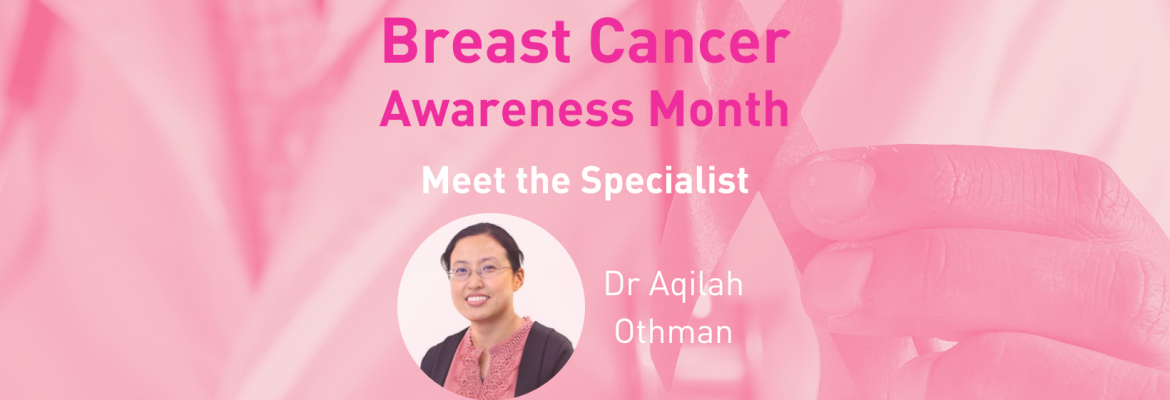
-
SE Asia (HQ)
+65 3158 9940
-
Australia
1300 798 820
-
New Zealand
+64 9801 0299
Breast Cancer Awareness Month: Meet the Specialist
- Home
- News Archive
- Breast Cancer Awareness Month: Meet the Specialist

- by Comms Department
- 0 Comments
Consultant Clinical Oncologist Dr Aqilah Othman says an ageing population, fewer and later pregnancies, a lack of physical activity, obesity and poor dietary habits may be contributing to a rising incidence of new breast cancer cases across Southeast Asia.
To mark Breast Cancer Awareness Month 2023, the Sunway Medical Centre oncologist discusses the incidence of breast cancer in Malaysia as well as the risk and fear of recurrence.
Q: How common is breast cancer in Malaysia?
A: According to the Malaysia National Cancer Registry Report 2012-2016 there were 13,485 breast cancer cases, with an approximate lifetime risk of 1 in 20 women.1
The number of breast cancer cases is projected to spike in the near future, and we believe that this could be due to an ageing population, as well as other risk factors including not having children or late pregnancies, a lack of physical activity, obesity, and poor diets, with the consumption of highly processed foods and unregulated supplements.
Q: What are the chances of a cancer recurrence following the original breast cancer diagnosis?
A: Up to 10% of women with early breast cancer will have a recurrence after treatment.2
The risk is higher for those with genetic mutations or those who have had suboptimal treatment. The biology of the tumour itself – for example, if it is HER2 positive or triple negative – also increases the risk of recurrence. We know that between 30 and 50% of HER2 positive breast cancer patients will relapse within 10 years without HER2 targeted treatment.
Q: Is the fear of recurrence almost universal and how can this be addressed?
A: Many women who have been treated for breast cancer are afraid that the cancer is still there, or that it will relapse. This is normal and I think it is a reasonable worry.
However, if this fear becomes an obsession or interferes with normal life activities then this is a serious problem that needs to be addressed.
Women should be assured that they have done whatever they can within their limits by pursuing and completing all recommended treatments prescribed by their oncologists, as well as modifying other risk factors, for example, increasing physical activity, adopting a healthier diet and lifestyle and paying attention to their mental and emotional wellbeing.
Some identified distraction strategies like work, exercise, meditation or praying can help to curb negative thoughts as soon as they start.
Support from family, friends, support groups and therapists can also help, but I find that many times it is the acceptance of the diagnosis by the individuals themselves, knowing that they are not the only ones and interacting with others who are in similar situations is effective.
What are the median survival rates of breast cancer in Southeast Asia?
A: There are big differences within and between each Southeast Asian country, however it is known that there are more late presentations, less treatment uptake and adherence leading to poorer outcomes in this region, compared to our western counterparts.
In some regions there is simply a lack of resources to identify and treat cancer optimally.
On the other hand, there are regions that have underutilised state of the art facilities and have less than ideal uptake of early detection programmes or timely treatment.
Q: Why is this the case?
A: Barriers include the inability to recognise or acknowledge symptoms, poor decision-making skills, lack of self and body empowerment, belief in alternative therapies and perceived cancer fatalism. Some patients believe that death is inevitable when cancer is diagnosed, and this can lead to delayed treatment even when diagnosed early.
Q: Why should women in Southeast Asia be vigilant so cancer is detected early?
A: Early detection and timely access to optimal treatments can save lives and improve outcomes. There is still a long way to go in integrating the psychosocial and cultural beliefs of the local population. We must continue to dispel myths, build awareness and address these to close the cancer gap.
References
- Azizah AM et al. Malaysia National Cancer Registry Report. 2012-2016
- Balasundram Set al. Asian Pac J Cancer Prev.19(9): 2409-2415, 2018.

